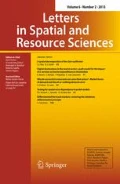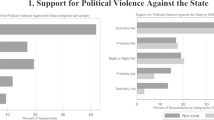Abstract
This study explores the impact of neighbor regions on the club convergence for Turkey. Markov chain analyses are augmented by using the spatial lag conditioning. The central hypothesis is that, having a rich (poor) spatial proximity increases the chances to move towards higher (lower) income classes. Our preliminary evidence covers the 1975–2017 period and points out that Turkish regions are not converging on average rather converging to varying income levels. This signals the formation of convergence clubs. Our augmented analyses highlight that the club convergence process is influenced from the income level of neighbor regions. Those regions whose neighbors belong to high income classes have higher chances to move to higher income classes, whereas the peripheral regions linked with the poor ones are getting more isolated. Our results highlight that regional policy framework and local economic activity has an influence beyond the administrative boundaries of regions. This calls for spatially flexible and smart local policies to combat with regional disparities.


Similar content being viewed by others
Notes
Turkey realizes a number of severe financial crises during the sample period. Two economic contractions of the period correspond to the 1994 and 2001 financial crises (− 5.5 and − 6% economic growth respectively). Consequently, in 2009 Turkey is influenced from the 2008 Global Financial Crises and the economy shrinks by 4.7%. Naturally, all these macroeconomic turmoils have possible effects on the regional growth performances. The extent of regional resilience to economic turmoils is not considered within this study. We regard this as a further dimension of regional disparities which could be better handled in a separate research.
While there is no universal rule for the right number of income classes, the scholarly literature uses five income groups to implement transition probability analyses (Quah 1993; López-Bazo et al. 1999). Le Gallo (2004) discusses that the exact number of income classes has negligible effect on the results. Still, we replicate all of the transition probability analyses with four income classes. Our results are virtually unchanged. These results are supplied in the Online Appendix.
Similar results from the spatial lag analysis with an inverse distance weight matrix are provided in the Online Appendix.
We would like to thank one of the anonymous reviewers for expressing the importance of the spatial mechanisms and its theoretical foundations.
References
Anselin, L.: The Moran scatterplot as an ESDA tool to assess local instability in spatial association. Spat. Anal. Perspect. GIS 111, 111–125 (1996)
Barro, R.J., Sala-i Martin, X.: Convergence. J. Polit. Econ. 100, 223–251 (1992)
Benos, N., Karagiannis, S., Karkalakos, S.: Proximity and growth spillovers in European regions: the role of geographical, economic and technological linkages. J. Macroecon. 43, 124–139 (2015)
Boratav, K., Yeldan, A.E., Köse, A.H.: Turkey: Globalization, Distribution and Social Policy, 1980–1998. Oxford University Press, Oxford (2001)
Doğruel, F.: Deindustrialization of old industrial regions in Turkey. Rives méditerranéennes 46, 93–108 (2013)
Dogruel, F., Dogruel, A.S.: Iktisat Uzerine Yazilar 1 Kuresel Duzen: Birikim, Devlet ve Siniflar Korkut Boratav’a Armagan, Iletisim Publications, chap. Turkiye’de Bolgesel Gelir Farkliliklari ve Buyume (2003)
Dogruel, F., Dogruel, A.S.: Openness and regional distribution of Turkish manufacturing industries. Top. Middle East. N. Afr. Econ. (2006). http://www.luc.edu/orgs/meea/. Accessed 3 June 2020
Ertur, C., Koch, W.: Growth, technological interdependence and spatial externalities: theory and evidence. J. Applied Econometr. 22(6), 1033–1062 (2007)
Filiztekin, A.: Convergence across industries and provinces in Turkey. Koç University (1998). http://myweb.sabanciuniv.edu/alpayf/files/2010/04/turkconv981.pdf. Accessed 1 May 2019
Fingleton, B., López-Bazo, E.: Empirical growth models with spatial effects. Pap. Reg. Sci. 85(2), 177–198 (2006)
Fujita, M., Krugman, P.R., Venables, A.: The Spatial Economy: Cities, Regions, and International Trade. MIT Press, Cambridge (1999)
Gezici, F., Hewings, G.J.D.: Regional convergence and the economic performance of peripheral areas in Turkey. Rev. Urban Reg. Dev. Stud. 16(2), 113–132 (2004)
Kang, W., Rey, S.J.: Inference for income mobility measures in the presence of spatial dependence. Int. Reg. Sci. Rev. (2019). https://doi.org/10.1177/0160017619826291
Karahasan, B.C., Bilgel, F.: In: Engin, N., Aslanoglu, E., Erdogan , E, Karahasan, B.C., Tata, K. (eds.), Turkiye Ekonomisinde Kalkinma ve Donusum: Taner Berksoy’a Armagan. Imge, chap. Türkiye’de Bolgesel Esitsizlikler: Yakinsama, Dagilim ve Mekan, pp. 341–380 (2018)
Karahasan, B.C., Dogruel, F., Dogruel, A.S.: Can market potential explain regional disparities in developing countries? Evidence from Turkey. Dev. Econ. 54(2), 162–197 (2016)
Knaap, E., Wolf, L., Rey, S.J., Kang, W., Han, S.: The dynamics of urban neighborhoods: a survey of approaches for modeling socio-spatial structure. SocArXiv (2019). https://doi.org/10.31235/osf.io/3frcz
Lagendijk, A., Kayasu, S., Yasar, S.: The role of regional development agencies in Turkey: from implementing EU directives to supporting regional business communities? Eur. Urban Reg. Stud. 16(4), 383–396 (2009)
Le Gallo, J.: Space-time analysis of GDP disparities among European regions: a Markov chains approach. Int. Reg. Sci. Rev. 27(2), 138–163 (2004)
López-Bazo, E., Vayá, E., Artis, M.: Regional externalities and growth: evidence from European regions. J. Reg. Sci. 44(1), 43–73 (2004)
López-Bazo, E., Vayá, E., Mora, A.J., Suriñach, J.: Regional economic dynamics and convergence in the European Union. Ann. Reg. Sci. 33(3), 343–370 (1999)
Magrini, S.: The evolution of income disparities among the regions of the European Union. Reg. Sci. Urban Econ. 29(2), 257–281 (1999)
Özötün, E.: İller itibariyle Türkiye gayri safi yurtiçi hasılası-kaynak ve yöntemler, 1975-1978. DIE (907) (1980)
Özötün, E.: Türkiye gayri safi yurt içi hasılasının iller itibariyle dağılımı, 1979-1986. ISO (1988)
Pellegrini, G.: Proximity, polarization, and local labor market performances. Netw. Spat. Econ. 2(2), 151–173 (2002)
Pfaffermayr, M.: Spatial convergence of regions revisited: a spatial maximum likelihood panel approach. J. Reg. Sci. 52(5), 857–873 (2012)
Quah, D.: Empirical cross-section dynamics in economic growth. Eur. Econ. Rev. 37(2–3), 426–434 (1993)
Quah, D.: Convergence empirics across economies with (some) capital mobility. J. Econ. Growth 1(1), 95–124 (1996a)
Quah, D.: Regional convergence clusters across Europe. Eur. Econ. Rev. 40(3), 951–958 (1996b)
Rey, S.J., Ye, X.: Comparative spatial dynamics of regional systems. In: Páez, A., Gallo, J., Buliung, R.N., Dall’erba, S. (eds.) Progress in Spatial Analysis, pp. 441–463. Springer (2010)
Rey, S.J.: Spatial empirics for economic growth and convergence. Geogr. Anal. 33(3), 195–214 (2001)
Rey, S.J.: Rank-based Markov chain for regonal income distribution dynamics. J. Geogr. Syst. 16(2), 115–137 (2014)
Rey, S.J., Montouri, B.D.: US regional income convergence: a spatial econometric perspective. Reg. Stud. 33(2), 143–156 (1999)
Shorrocks, A.F.: The measurement of mobility. Econometrica 46, 1013–1024 (1978)
Solow, R.M.: A contribution to the theory of economic growth. Q. J. Econ. 70(1), 65–94 (1956)
Temel, T., Tansel, A.: Convergence of sectoral productivity in Turkish provinces: Markov chains model. Int. J. Appl. Econometr. Quant. Stud. 2(2), 1–35 (2005)
Temel, T., Tansel, A., Albersen, P.J.: Convergence and spatial patterns in labor productivity: non-parametric estimations for Turkey. J. Reg. Anal. Policy 29, 3–19 (1999)
Tian, L., Wang, H.H., Chen, Y.: Spatial externalities in China regional economic growth. China Econ. Rev. 21, S20–S31 (2010)
Turkstat: Turkish Statistics Office Regional Database (1987–2001) (2019a). https://biruni.tuik.gov.tr/bolgeselistatistik/. Accessed 1 May 2019
Turkstat: Turkish Statistics Office Regional Database (2004–2017) (2019b). https://biruni.tuik.gov.tr/bolgeselistatistik/. Accessed 1 May 2019
Yeldan, E.: Küreselleşme sürecinde Türkiye ekonomisi: bölüşüm, birikim ve büyüme. İletişim Yayınları (2016)
Yeldan, E., Ünüvar, B.: An assessment of the Turkish economy in the AKP era. Res. Policy Turkey 1(1), 11–28 (2016)
Acknowledgements
Earlier versions of the manuscript is presented at the 18th Annual Conference of Turkish Regional Science Association (2018) and Workshop on Regional Inequalities in Turkey: Methodology, Data and Impact of New GDP Revision on Regional Accounts in Turkey (2019) organized jointly by Turkish Regional Science Association, Marmara University Faculty of Economics and Marmara University Center for Regional Development. Author is grateful to the participants, particularly to Yasemin Basturkcu, Alpay Filiztekin, Fatma Dogruel, Suut Dugruel, Tuzin Baycan, Ferhan Gezici and Haluk Levent for useful comments and suggestions. Author would also like to thank to Firat Bilgel for his critical comments and constructive suggestions on the earlier versions of the paper.
Author information
Authors and Affiliations
Corresponding author
Ethics declarations
Conflict of interest
The author declares that he has no conflict of interest.
Additional information
Publisher's Note
Springer Nature remains neutral with regard to jurisdictional claims in published maps and institutional affiliations.
Electronic supplementary material
Below is the link to the electronic supplementary material.
Rights and permissions
About this article
Cite this article
Karahasan, B.C. Can neighbor regions shape club convergence? Spatial Markov chain analysis for Turkey. Lett Spat Resour Sci 13, 117–131 (2020). https://doi.org/10.1007/s12076-020-00248-z
Received:
Accepted:
Published:
Issue Date:
DOI: https://doi.org/10.1007/s12076-020-00248-z




